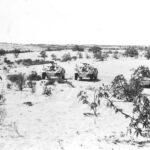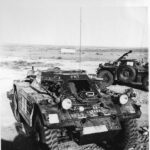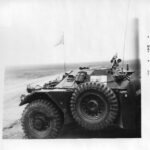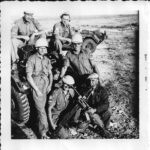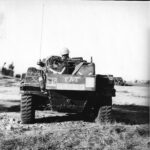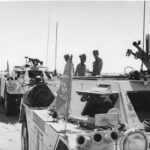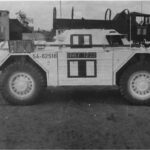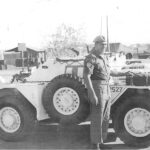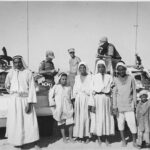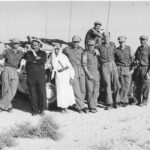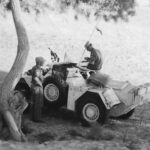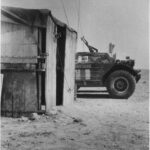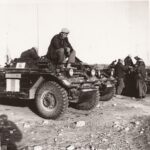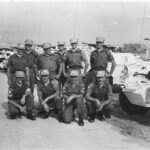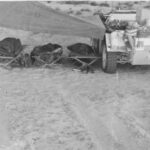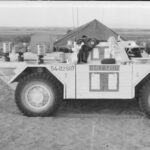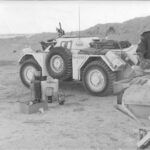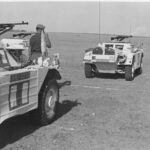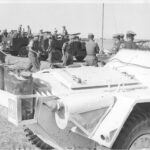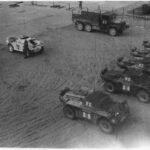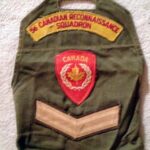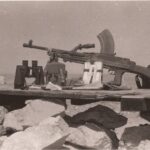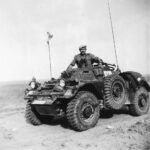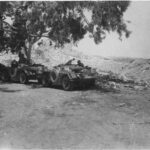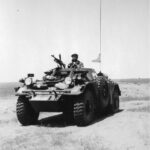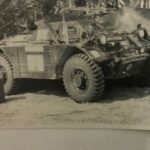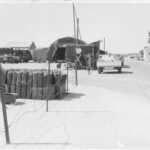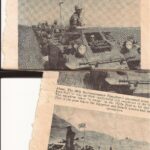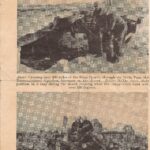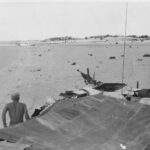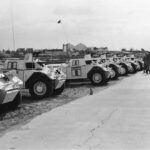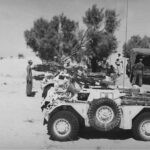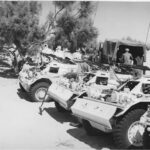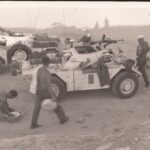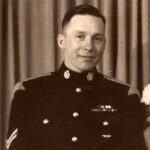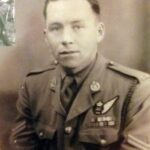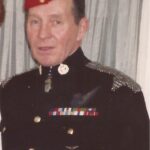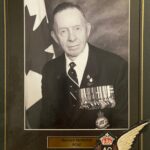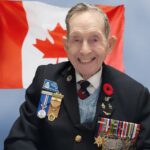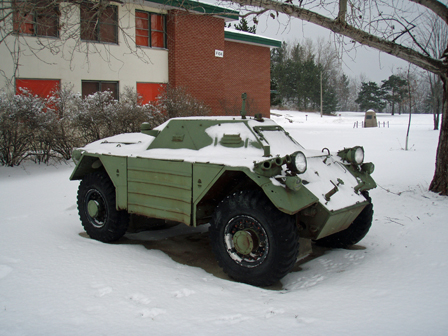
BIOGRAPHY OF BERNARD MCNICHOLL shown here [photo to be added] standing beside Ferret 54-82595 in Sinai with UNEF. This Ferret, also used in UNFICYP in Cyprus, is now in CFB Petawawa as a monument vehicle in front of the Royal Canadian Dragoons Headquarters.
Ferret 54-82575 may be UNEF 1213.
(More McNicholl photos are at the bottom of this page)
Bernard commanded Ferret UNEF 1213 which he nicknamed “PAT” (after his wife), 2 Troop, 56 Reconnaisance Squadron, UNEF, Sinai as part of Canada’s contribution to the first United Nations Emergency Force (UNEF) separating Egypt from Israel in 1957. He had a fascinating career in the Royal Canadian Canadian Air Force, Canadian Army, and with Cadets.
I had the pleasure of meeting Bernard McNicholl a number of times in Chilliwack, B.C. as he went for his early morning coffee. Special thanks to one of his sons, Shawn McNicholl, for the information, photos and permission to post them on my web site.
The following information has been edited slightly to correct and explain military terms etc. I changed it to third person so that readers readers do not think that it is me “speaking”. Additional comments by me are in square brackets [ ].
Bernard McNicholl lived in Montreal, Quebec, Canada, and went to Darcy McGee High school. In the Spring of 1941 at age 15 ½ he registered for the home defence conscription, (normally need to be age 16). He had his step-father who was a WW1 veteran sign permission to enlist so likely let them believe he was age 16. In the months that followed he would frequent the recruiting booth at the Eaton store on St. Catherine’s Street [Montreal]. They had a Link pilot flight trainer [in a hanger, a student pilot sat in a box with the hood covered and “flew” by instruments] there on display and he would become familiar with it as he intended to join the RCAF as a pilot. In Spring of 1942 he graduated high school and the entire high school class went to the Montreal recruit centre (west end) to joined the RCAF. In Aug 1942 he formally enlisted, however he was only 16 ½ but he carried on with his age (DOB)[Date of Birth] listed on his home defence conscription of 17 ½, so he could enter pilot training. He headed off the RCAF recruit training at Lachine, QC (Footnote 1) (West of Montreal), where he started off 2 months in the manning pool training. This consisted of drill, rifle drill with a Ross rifle, military discipline and some rifle handling with a Model 1917 rifle with blanks.
Next, he headed off to Truro, Nova Scotia for War Emergency Training Plan (WETP). There they boned up and updated on academics like math, as some older candidates were years out of school. Then they cover wireless and morose code communication training, military history, aircraft recognition and other administrative work. While on WETP they were on probation and wore a red backing on their wedge cap. (Winter 1942-43). After completion of WETP he went to Initial Flying Training School (IFTS) located at the Toronto fair grounds, late winter 1943. There they did all the theory of flight to navigator, bomb aimer and pilot recruits. All theory of flight such as wing loading, controls, aero dynamics, air navigation and weather (winds, cloud formations and thermals).
In early spring of 1943, he was sent to a six-week Elementary Flying Training School (EFTS) at 11 EFTS Cape Madeleine, QC. Here they wore the white backing on their wedge cap as air crew training. They learned how to fly old biplanes which were Fleet Finch (128 Hp with 5-cylinder engines). They had to learn how to take off, land and perform all maneuvers of flying. They would have to complete 70 flying hours while doing map navigation and following visual flight rules (land marks). (Footnote 2) In the summer of 1943, he graduated to No 13 Service Flying School at St. Hubert QC. (Footnote 3) This was essentially the advanced flying school where they learned to fly the Harvard Mk2 fighter trainer. They had to perform 170 hours of flight, basic gunnery air to ground as well as navigation. About mid-way through training, he was involved in unauthorized low flying incidents and dangerous flying (buzzed the recruit train). While under investigation for incident his age was verified as not 18 ½ but rather 17 ½. This was a liability issue as you needed to be 18 to be at advanced pilots training because of hazard of crashing (death) and losing an expensive aircraft, so he would have to be grounded until he turned of age. (1942 he joined the RCAF under aged with service # R168563, but then in 1943 he was re-enlisted in the RCAF with correct age and a new service # R268563).
It was now Fall of 1943 and they needed him in the war effort and not sitting idle, so he was offered air gunner or bomb aimer on heavy bombers as he already had training on these skill sets. He selected Air Gunner and went off to #10 Bomber and gunnery training unit at Mt. Pleasant PEI (near Summerside) (Footnote 4). Here they trained using the Bristol turret on the Bolingbrook light bomber.

Bolingbroke bomber (Wikipedia)
This was a two-engine light bomber where they took turns in the turret to engage drogue targets pulled by old Fairy Battle aircraft. They performed 13 hours in the turret. There were a few aircraft crashes and accidents during training. An interesting event was when on route to PEI to start training, he elected to hop a ride in a Bolingbrook aircraft that was going Mt Pleasant, so he flew vice [?] taking the train and ferry. The only problem is the pilot drifted east off course and missed PEI.

“Liberator” B-24 maritime patrol bomber of the RCAF (DND photo)
Luckly, they spotted a Liberator [B-24] bomber and followed it to an airfield which turned out to be Gander Newfoundland. The next day they flew into Mount Pleasant. Next Bernard was sent to Trois Rivieres for specialized training instructed by commandos. These instructors were providing the basics of what to do if shot down over enemy territory, such as escape and evasion, conduct after capture, how to work with the underground and understanding the escape network. There was also some weapons training with 30-06 Model 1917 rifles. This was likely in the January 1944 time frame.
In Feb 1944 he was sent to No. 20 Operational Training Unit (OTU) at Lossiemouth Scottland. (Footnote 5) This is where all crews perform their advance crew level training for pilots, Navigators, Air gunners, radio operators, flight engineer and bomb aimer. The aircraft available for training was the Wellington medium bomber. Benard practiced his rear gunner live fire training in the Wellington and all crew trained with all aircraft systems such oxygen supply, communications, and safety systems. It was at OTU that he got his nick name Gremlin (Grem). This was due to a couple of accidents that he was in as the rear gunner, one of which was a Free French pilot who crashed on takeoff (lost an engine). A number of personnel died, but the tail section with rear turret of the Wellington broke off, so he was extracted mostly un injured. Eventually his nick name was regarded as good luck, since his crew went on and made over 30 operations. OTU is where the crews mutually team up and decide who will be in which crew, with the pilots blessing. Since he had topped his gunnery training, one of the older pilots Dick A. Smith selected dad as his rear gunner. Now May of 1944 the new formed crew proceeded to Langard RAF station for heavy bomber conversion training. There they did their final work up training as a crew on the older Halifax Mk2 heavy bombers. He was able to hone his gunnery skills with the Boulton and Paul rear turret and practice drills with the pilot, such as evading and engaging night fighters that come up at the rear. Apparently the Skipper was very keen on rehearsing these drills and getting extra air time with the crew. This would set the stage of this crew becoming a survivor crew.
Following the conversion training the crew awaited their operational posting. In Fall of 1944 orders soon came in for two of the more regarded crews to proceed to 192 Sqn RAF (Special Duty) at Foulsham Airfield. Having an older pilot and experienced navigator, his crew was one of the two crews who were selected for special duty operations. 192 Sqn was a radar frequency gathering and countermeasures unit within the 100 Group of Bomber Command electronic warfare operations.
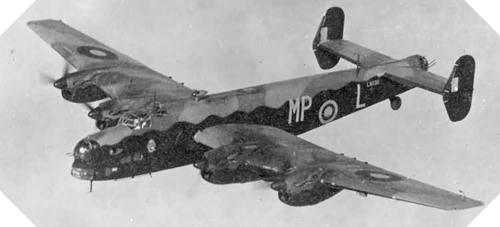
Hanley-Page Halifax Mark II (https://www.dday-overlord.com/)
Their new aircraft were Halifax Mk.II or III bombers outfitted with specialized equipment and had an 8 th crew member who was a special operator. The wing [?] bomb bays carried bombs, “Window” [strips of or including tinfoil, dropped to confuse the enemy radar] or had extra fuel for the longer trips. Bernard’s role did not change, as he was still responsible for the rear defence of the aircraft and protecting the rear. The crew went on to complete their 30 operations, with their final operation just a few days before VE day. He went into combat at age 18 in Dec 1944 and was age 19 on VE Day. He was promoted around VE Day to WO [Warrant Officer] Class 2 and the crew received their tour of operation wings. Details of operations are contained in the 192 Squadron operational record books. After VE Day [8 MAY 1945] he volunteered for the Pacific and was posted out of 192 Sqn 16 June 1945 to a holding unit. A few stories from the missions: # 39’s crew were lucky, it was on long trips Bernard soon learned how to keep his hands from freezing by placing them over the gun heaters which kept his 4 machine guns from freezing. (Dec 44 – May 45). … He always stayed alert scanning and slewing his rear turret. The turret would catch the wind and the pilot (Skip) [Skipper] would have to compensate depending on which way he was slewing. The skip never had to go on intercom as they both knew each other were awake. Also the skip never used the auto pilot as it was too slow to disengage if the rear gunner … [Bernard] called “fighter corkscrew port go!” This was a survivor crew, who would make their 30 ops, some trips were less eventful than others. However other trips had crew wounded from flak and a battle-damaged bomber limping home in thick fog and very low on fuel.To evade German night fighters they would perform aggressive evasive maneuvers. …[Bernard], being the rear gunner was the eyes on and rear defence. …[He] would call out fighter port or starboard go-go-go and the pilot would dive the bomber in a corkscrew to evade and lose the fighter in the dark. Either …[Bernard] would fire into fighter in the corkscrew or hold off [so] as to not give away their position if fighter lost them. On one occasion during a corkscrew, they nearly collided with a German ME 110 night fighter. Some of the battle damage was bad such as one of the inboard engines being hit by flak and a prop smashing through the fuselage near the pilot and radio operator. Another time the dingy [inflatable raft in case of a water crash landing] dislodged and struck and damaged the tail section. When …[he flew] with another crew, they had to do a controlled abonnement [abandoning the aircraft] in flight asdamage and fuel loss meant they would not make an airfield, so they bailed out while the bomber was still stable. While returning from the target a Halifax bomber from another squadron slipped out of the clouds dangerously close to the front of their bomber. Collisions were a big threat at night, but was dusk now and the pilot was able to back off. However flak struck this bomber in the mostly empty fuel tanks and it disintegrated in front of them. …[Bernard], being in the rear did not see it, but he heard it and saw an engine fly by. Operations varied from along fortified enemy coast line radar installations to deep into the German interior with the main bomber waves, usually in first with the pathfinders.
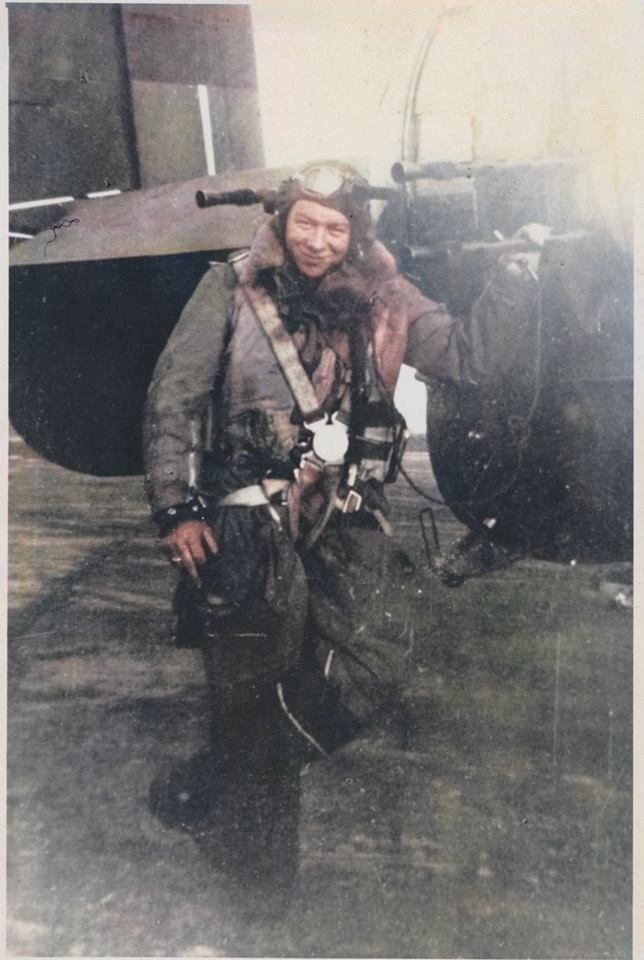
Bernard McNicholl’s service in the Canadian Army and the Cadet movement.
On Victory in Europe day, Bernard volunteered for the Pacific, so he repatriated to Canada to start training for the Pacific where he would get grouped with a new bomber crew. However, the war ended soon in September with Victory over Japan, so vast components of the RCAF were demobilizing. In 1946 … [Bernard] joined the Royal Montreal Regiment which were Infantry in the militia component, but were still at active war status strength. He was a Sergeant and instructed machine-gun training and drove light track [Universal] Carriers. When that unit was reduced to reserve peace time strength status in 1948, the unit went from 800 to less than half. Bernard then went off to joined the Regular Army with Royal Canadian Armoured Corps, service # SD190519. He graduated from his basic armoured crewman training in [Camp, now CFB] .. Borden, Ontario in 1949.
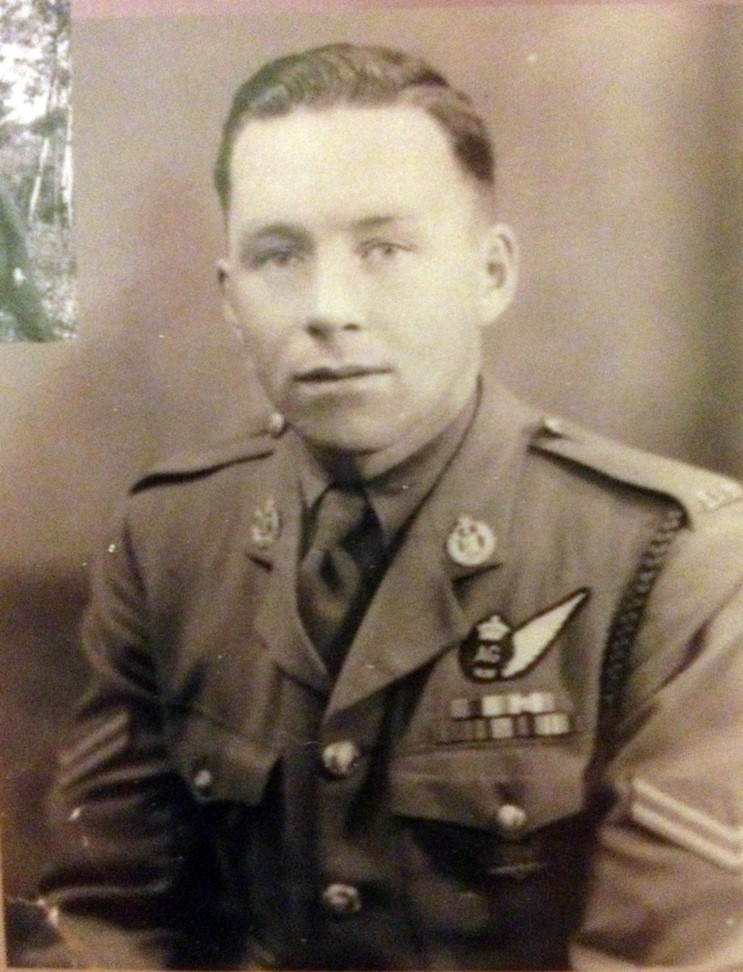 He was then sent to the Lord Strathcona Horse (LdSH) an armoured regiment located in Calgary. However, he soon found himself posted for a couple of years to Fort Churchill, Manitoba, as camp support staff, which included driving, maintaining and operating the fire trucks. He returned to Calgary in 1951 (the LdSH home base) where he did some courses dealing with the Sherman tank. In late 1951 he was selected for the Centurion tank test team where he worked on this trail and evaluation until early 54. He trained on the Centurion in the UK late summer of 1952. He was promoted to Cpl in 1954 and completed his senior leader’s course. He continued working in C Sqn of the LDSH until late 1956. He was married in April 9,1955 to Patricia Joan Cathcart and Bob was born in 3 March 1956.
He was then sent to the Lord Strathcona Horse (LdSH) an armoured regiment located in Calgary. However, he soon found himself posted for a couple of years to Fort Churchill, Manitoba, as camp support staff, which included driving, maintaining and operating the fire trucks. He returned to Calgary in 1951 (the LdSH home base) where he did some courses dealing with the Sherman tank. In late 1951 he was selected for the Centurion tank test team where he worked on this trail and evaluation until early 54. He trained on the Centurion in the UK late summer of 1952. He was promoted to Cpl in 1954 and completed his senior leader’s course. He continued working in C Sqn of the LDSH until late 1956. He was married in April 9,1955 to Patricia Joan Cathcart and Bob was born in 3 March 1956.
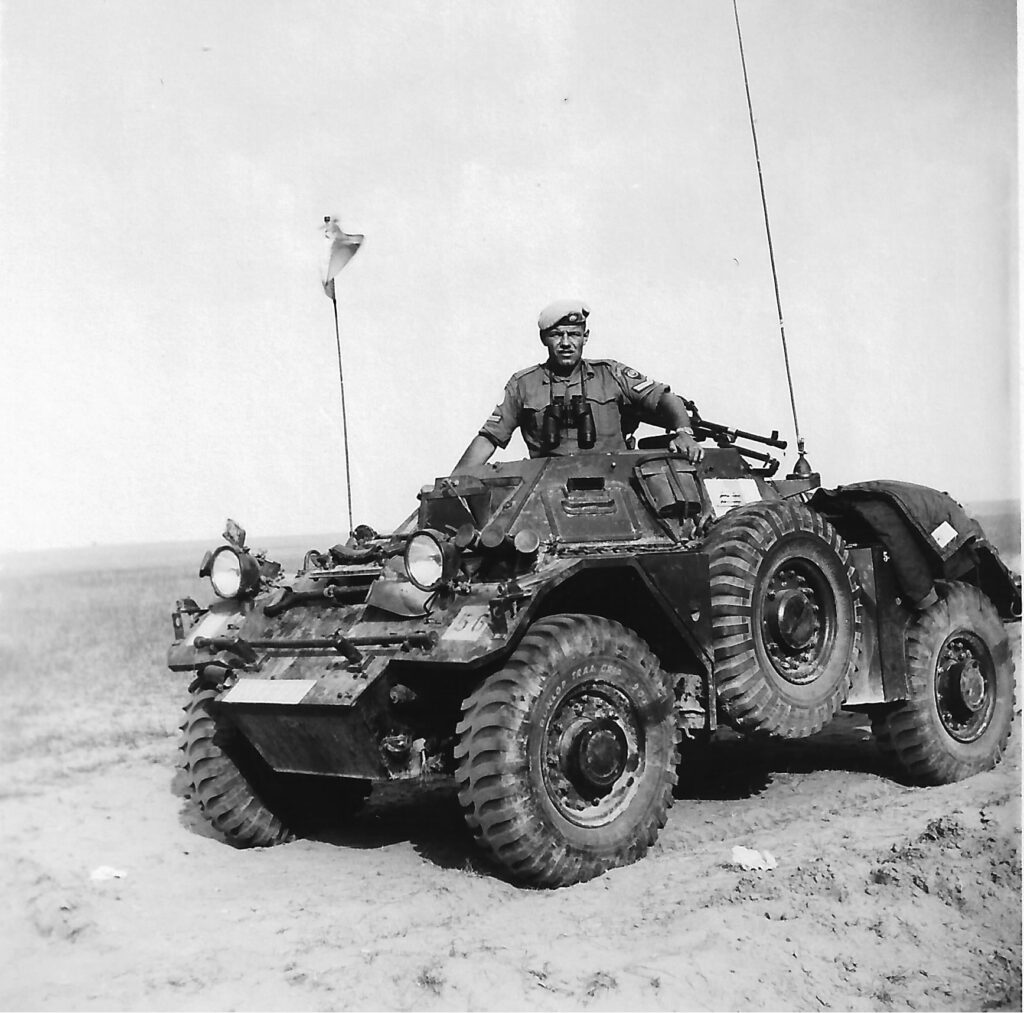
Shortly after this he was sent Petawawa to train up for UNEF1 deployment to the Suez Canal crisis. He deployed with 56th Canadian Reconnaissance Sqn to Egypt in 1957 where they operated in the Sinai Peninsula and the Gaza Strip for nearly a year. He was a senior corporal but was in fact the 2 Troop Sgt with in the Sqn. This was the UN’s and Canada’s first major UN operational deployment as a peacekeeping mission. In 1958 he was back in Calgary where he was assigned to the Head Quarters Sqn of the LdSH for a year, and then over to C Sqn until 1962. (Bern was born in 1958 and Shawn was born in 1961). In 1962 he was posted to Vernon BC, attached to the British Columbia Dragoons. He supported this unit along with other reserve units and the annual Army Cadet Summer training program. In 1965 he returned to Calgary in preparation for the unit (regiment) to deploy to West Germany. Dec 1965-1967 he, with the family were posted to West Germany with the LdSH in support of NATO operations. On returned to Canada he was posted to Gagetown NB, however in early 1968 he requested a specialized assignment in order to be posted to the Nanaimo military camp at the BC provincial emergency nuclear fallout shelter. He commenced work in summer of 1968 in the underground fallout shelter until he retired from the Regular force in 1971 and transferred to the Reserves at Camp Nanaimo. He retired from the reserves in 1982 at age 55 (CRA) [Compulsory Retirement Age], hence ending his career in the Canadian Army.
From the early 1970’s until 1983 he volunteered as a Navy League of Canada Cadet Officer and went on to be the commanding Officer of the Nanaimo Naval League Cadet Corps and then finally as the area Commander for Vancouver Island. While XO [Executive Officer] and CO [Commanding Officer] of the Corps, his Corps won the top corps in Canada a number of times and place in the top three in the years they didn’t win. During his tenure with the cadets, he proved to be a great mentor and influence for the cadet youths that were under his leadership. In 1983 he became a member of the local Royal Canadian Air Force Association [RCAFA] where he later become the Wing President. He served as a RCAFAC Collishaw Wing president in the Nanaimo 1993-1994, volunteered as the Wing’s Air Cadet liaison officer and was part of a RCAFA volunteer team that hiked into remote locations on Vancouver Island to place cairns at different RCAF crash sites. This was to honour all the RCAF crews that had perished at these locations during WW2. He moved to Chilliwack BC around 1995 where he again became active with the local RCAFA and the Royal Canadian Legion. He was a member of the LdSH association, Ex-Air Gunners association, Royal Canadian Air Force Association and was … a member of the Royal Canadian Legion since 1946, (over 61 years).
Bernard McNicholl’s Medals
1. 1939-45 Star, with RAF Bomber command bar
2. France/Germany Star with Atlantic Bar
3. Civil Defence Medal
4. CVSM Medal with Clasp and Bomber Command Bar
5. War Medal 1939-45
6. SSM with NATO Bar
7. Peace Keeping Medal
8. UNEF1
9. Queens Silver Jubilee Medal
10. CD2
References:
1 https://en.wikipedia.org/wiki/RCAF_Station_Lachine
2 https://en.wikipedia.org/wiki/Cap-de-la-Madeleine
3 https://en.wikipedia.org/wiki/No._13_Service_Flying_Training_School_RCAF4 https://en.wikipedia.org/wiki/RCAF_Station_Mount_Pleasant
5 https://en.wikipedia.org/wiki/RAF_Lossiemouth
OBITUARY
February 10, 1926 – July 17, 2023
In loving memory ~ Bernie McNicholl of Chilliwack, B.C., passed peaceably at the Chilliwack General Hospital on 17 July 2023 at the age of 97. Bernie was born on 10 February 1926 in Montreal Quebec. He grew up in Montreal, and on the completion of high school at age 16, he and his classmates headed to the recruiting centre to volunteer for war service. During WW2 he served in the RCAF 1942-1945 as a rear gunner in heavy bombers, in 192 Squadron RAF, of 100 Group – Special Duty (electronic warfare). He entered combat at age 18 and completed over 30 operations over Nazi Germany, earning the tour of operations wings. He was age 19 and a Warrant Officer 2nd Class when the war ended. He served in the Canadian Army from 1946 – 1982, first with the Royal Montreal Regiment, then in 1948 with the Royal Canadian Armour Corps (LdSH and RCD).He deployed for a year to Egypt in 1957 during the Suez Cannel crisis (UNEF1). He served in Germany during the Cold War. In the 70’s and 80’s he was extensively involved with the Navy League Cadets of Canada, ultimately, serving as the CO of the local Nanaimo NL and then as Commander of the NL Vancouver Island Division. Bernie was also a long-standing member of the Air Force Association of Canada (AFAC), WW2 Ex Air Gunners Association, Lord Strathcona Horse Association, and was a member of the Royal Canadian Legion for over 61 years. He served as the AFAC Collishaw Wing president in Nanaimo from 1993-1994, volunteered as the Wing’s Air Cadet liaison officer and was part of an AFAC volunteer team that hiked into remote locations on Vancouver Island to place honorary cairns at different WW2 RCAF crash sites. It is believed Bernie McNicholl was the last known living WW2 veteran in the Chilliwack area. He is survived by his wife Patricia of 68 years, sons: Robert, Bernard, and Shawn (Tanya), 5 grandchildren, one great-granddaughter, one step-grandson and 4 step-great-grandchildren.

